Genre: Action Developer: Psygnosis Publisher: Electronic Arts Players: 1 Released: 1991
One of the advantages of the Genesis was its relative power compared to computers of the time, making it a viable platform for PC ports. Electronic Arts, originally a publisher of innovative PC games, seized advantage of this new market and unleashed many games on the system. One of EA’s stable of companies that would benefit from this arrangement was Psygnosis, a much-lauded PC developer known for its beautiful but extremely difficult games. The Killing Game Show is one such game.
Yes, this is a review of The Killing Game Show, the Japanese Mega Drive version of the Genesis’ Fatal Rewind. Apparently, the word “killing” is bad enough to have changed – I guess even Sega’s loose violence policy had its limits. That’s not the only difference, though, as the FMV-ish intro from the original game was axed from the Genesis port yet is still available in the Mega Drive one. The scene shows your character awaking in its ED-209 looking cyborg body suit and taking practice shots on a moving target, hardly anything to warrant its removal. The only possible reason I can guess is perhaps EA thought the complete lack of sound or music during this cinema would confuse US consumers, thinking their game was defective. The Japanese version also has a much-welcomed easy mode and free play option available from the start, while the Genesis game is limited to three continues and begins on its normal mode. It’s also worth noting that the Japanese game’s case is larger than usual, about an extra 1/3 thicker than the standard Genesis or Mega Drive case. Nonetheless, aside from these differences, the game is largely the same across both regions, and this review can apply to either one.
Originally designed by Martyn R. Chudley for the Commodore Amiga, The Killing Game Show is one of many games influenced by Stephen King’s The Running Man, the story of Ben Richards, a man who competes in a violent contest to win money to help fund the costs of treatment for his sick daughter. Unfortunately, little is done to carry on the theme throughout the game. You’ll encounter cameras in the foreground here and there, but for a game which opens with, “AND NOW IT’S TIME FOR THE GREATEST SHOW ON EARTH,” I’d expect a more appropriate atmosphere with announcers, crowds, and so forth as seen in Smash T.V. That quibble aside, the graphics are well done, with each pair of the twelve levels sporting a unique theme (Greek, Egyptian, etc.) to help vary the look of the game, even if the stage layout and action largely remains the same.
Your character, stripped of his skin and limbs (which is not seen in the game), is encased in a cybernetic suit with a couple of guns strapped onto it. The suit runs around on its arms and is capable of leaping over gaps and scaling walls while seeking out the exit to the level. The animation of the character sprite and enemies is really well done – Hostile Artificial Life Forms have a 3-D look to them as they dart and spiral around to attack, which looks impressive despite all of them resembling similarly sized geometric oddities. The HALFs will attack at certain points in the level, and defeating each wave will net a small health bonus. Along the way, you’ll be able to obtain weapon upgrades and items to help you out as well.
There are three different weapon bonuses (shots, missiles, and lasers) each with three shot variations. You can only hold one weapon at a time, and each weapon has limited ammunition, meaning you’ll be exchanging weapons quite a bit per level. You also will be swapping out your item slot quite a bit, as later levels will have doors where you’ll have to locate a key to advance. While there are other items in the game, the reliance of keys to get by doors and inability to carry more than one item makes the rest of the bonuses useless. Uncovering a health power-up sounds great, except that you have to use it then and there — no saving for later encounters when you can use it. This should not be a big deal given how useless some of the items are: Oracles will display a “hint,” often a useless message such as “have a nice day!” or “we’ll be raising hell tonight!” while empty “switch” items do nothing but waste your available item slot. Unfortunately, having to carry keys around means you won’t be able to make use of the DOLL (Deadly to Organic Life Liquid) freezing item much, which is frustrating, as it temporarily stalls your greatest threat.
From the moment you start playing, DOLL begins to slowly flood the level. The challenge in avoiding it is not so much due to it flooding the level quickly as it is the amount of searching and backtracking you need to do to locate keys, doors, and the exit. Psygnosis games are typically memory intensive, and The Killing Game Show is no exception. Getting lost in a level is not an option; to succeed at the game is to know the levels in and out. Here is where you thank the Mega Drive game for including unlimited continues, as the game is challenging enough on its own without the credit restriction.
Being able to continue attacking the game indefinitely makes the game’s unique replay feature more useful. When the character dies, the player’s next life will begin retracing the same route and actions as it did before. You can speed up the action to get to whatever point you’d like to take over, and being able to advance to the next challenge and bypass earlier mistakes quickly is a great addition and is really forward thinking on the developer’s part. Think of how many games would force you to replay the same sections again and again just to reach that one point where, if you miss, you have to do it all over again. For a game as difficult as The Killing Game Show, this is almost a necessity, and it’s difficult to think many would have the patience in this day and age to memorize the game in and out to be able to complete it in one sitting. (Contrary to the Genesis game’s title, you cannot “rewind” the computer-controlled replay, though I suppose Fatal Fast-Forward just doesn’t have the same ring to it.)
Even with The Killing Game Show‘s fatal fast-forward feature, the game manages to pose a challenge to the most hardened 2-D action veteran. Nice graphics and a good though not memorable arcade soundtrack round out a unique shooter that will test one’s memory and endurance rather than his or her twitch skills, as if someone mated R-Type with a platformer. It’s a good game for what it does, but for a system known for its excellent array of shooters, The Killing Game Show finds itself struggling to make a name for itself. Whether or not it succeeds depends on if players today can still enjoy being punished for lack of knowledge prior to playing, being unable to survive purely on twitch skill alone. Unfortunately for it, I think most players today will not be so welcoming to its old school design and challenge, finding it more frustrating than fun.
SCORE: 6 out of 10


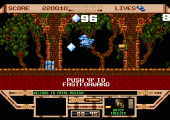
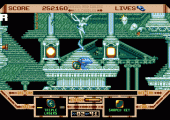
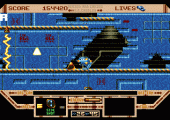
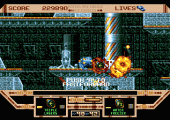
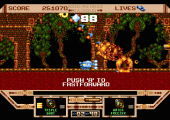
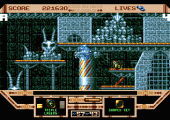
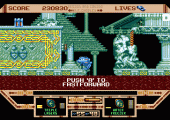
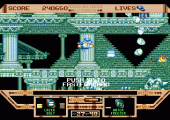
Recent Comments